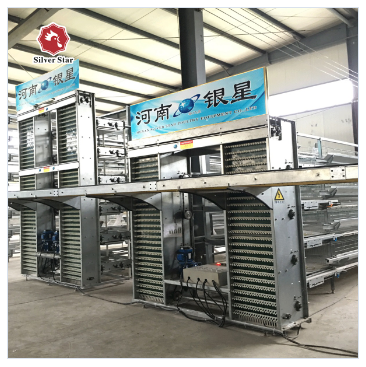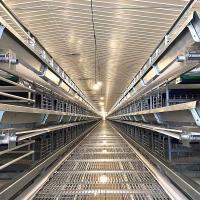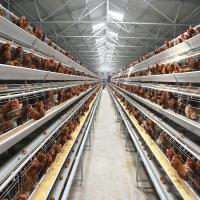Hot-dip Galvanized Battery Cage System for Laying Hens in Poultry
Farm Housing
management
The layer chicken cage
Cage-raised chickens are housed in cages, restricting their ability
to choose environmental conditions and depending solely on humans
to provide suitable conditions for survival and production. Hence,
cage-raised chickens require advanced feeding and management
techniques.
Cage rearing is the predominant three-dimensional method for
raising chickens and is widely used for off-ground production. More
than 80% of laying hens in developed countries are housed in cages.
In China, cage rearing has gained popularity and shown promising
results due to improvements in cage materials and structures. It is
recognized as the future direction for commercial production of
laying hens, chicks, breeders, and broilers, offering significant
advantages over traditional floor rearing methods.
In cages, a higher density of chickens per unit area means
substantial savings on housing and land compared to floor rearing.
Cages are utilized to isolate chickens and prevent epidemic
outbreaks.
Cage systems streamline management tasks, saving labor and
improving productivity.
Controlled environmental conditions in cages promote uniform
growth, high and stable egg production rates.
Observation and removal of unhealthy chickens in cages ensures the
health and productivity of the flock.
Reduced ground contact in cages minimizes parasitic diseases and
lowers medication costs. Elimination of bedding material saves
expenses.
Maintaining clean and hygienic conditions in chicken houses
enhances product quality by preventing egg contamination due to
feces.
Limiting chicken activity in cages reduces feed consumption,
increases feed conversion efficiency, and improves economic
outcomes.
Cage systems make it straightforward to collect chicken manure,
which can be used effectively as feed for pigs and fish after
fermentation.
Enhancements in feeding management and advancements in cage
materials can address issues such as nutritional deficiencies,
fatty liver syndrome, egg-laying fatigue, chest cysts, brittle
bones, and flexible bones in cage-raised chickens to varying
degrees.
Multi-layer coops can promote the health of chickens
Poultry farmers often struggle to achieve healthy outcomes in
chicken rearing due to their negligence in utilizing multi-layer
coops. These coops are pivotal in maintaining chicken health and
boosting reproductive efficiency.
Unlike a standard wire cage equipped with a metal mesh floor and
heating elements, a well-designed multi-layer chicken coop serves a
different purpose. Its wire flooring is engineered to promote
efficient fecal removal, reducing waste accumulation around the
flock and mitigating the risk of fecal-borne diseases. This
proactive design supports chicken health and protects farmers'
interests effectively.
Increase egg production
The productivity of chickens is closely tied to their health, and
providing enrichment cages can greatly enhance their egg production
capacity.
It's been estimated that 60% of eggs used in products such as
mayonnaise, sandwiches, and cakes originate from caged chickens,
highlighting the preference for multi-layer cage systems to
optimize egg production
Product introduction
Henan silver star cage net introduction, 1250 type frame layer
layer cage, scope of application: laying hens, breeding hens. Each
cage net 650 mm long, 1250 mm wide, each cage net around a door,
each door 650 mm long, 650 mm deep, 500 mm high. Large open space
for maximum comfort, precise structural details to enhance welfare,
up to 9 animals per door. The chicken has an area of 452 square
centimeters. Each cage net feeding capacity of 18.
The breeding capacity of each compartment of three layers is 54.
The breeding capacity of each enclosure is 72. The breeding
capacity of each enclosure is 90. There are 108 birds in each
enclosure of six floors. Four layers are the most common.
Multilayer partition structure optional, duplex multilayer
structure generally to take 4 plus 4 eight layers, or 3 plus 3 plus
3 nine layers. Reduce housing costs. Improve the overall value. To
learn more about related products, matching related automatic
equipment welcome to inquire
| 3-tiers | 0.65*1.25*2.65 m | 54 chickens |
| 4-tiers | 0.65*1.25*3.3 m | 72 chickens |
| 5-tiers | 0.65*1.25*4.6 m | 90 chickens |
| 6-tiers | 0.65*1.25*4.9 m | 108 chicekns |
| 7-tiers | 0.65*1.25*5.5 m | 126 chickens |
| 8-tiers | 0.65*1.25*6.2 m | 144 chickens |
| 9-tiers | 0.65*1.25*7.2 m | 162 chickens |

















